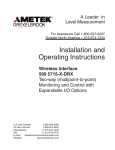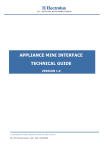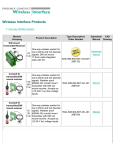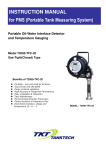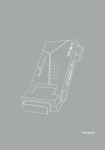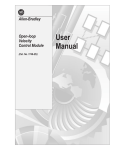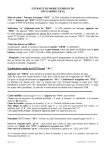Download Sierra Wireless 350 User guide
Transcript
User Guide 2110195 Rev 1.0 December 1999 o Welcome o Overview o Components o Supported Prods. o Safety Notices o Specifications o Installation o Using AirBooster o Troubleshooting o Service o Contact Us Welcome to the AirBooster™ 350 RF amplifier The AirBooster 350 is an intelligent RF amplifier for boosting some Sierra Wireless Class III (600mW) CDPD devices to Class I (3W). The amplifier is an "intelligent" booster in that it does not simply apply a fixed gain to a varying input RF level as a linear amplifier would. Instead, the AirBooster amplifier takes a constant RF level from the CDPD device and applies as much gain as the CDPD system requires at that moment. A GPS Option is also available, adding a GPS receiver inside the package. This is available as a field upgrade kit or pre-installed at the factory. Documentation related to GPS is covered in a separate section. Your AirBooster 350 Components All AirBooster 350 packages will include the following components: ● ● ● AirBooster™ 350 RF amplifier. Power Cable. Sierra Wireless Product CD-ROM with this Documentation including a 3 Year Warranty. 4 Screws with Washers. Mounting Template. ● Quick Start Guide. Units with the factory installed GPS option will also include: ● DB-9 Serial Cable. Additional accessories are available from Sierra Wireless. These include: ● ● RF Connector Cables (an assortment of lengths and connector options are available). ● GPS Options (Factory Installed or Field Upgrade Kit). ● GPS antennas (Magnetic or Hard Mount options). For details on these and other Sierra Wireless accessories contact sales or visit our web site. ● Supported Products At the time of this writing, the AirBooster 350 RF amplifier is supported by the following Sierra Wireless products: AirCard® 350 CDPD Adapter ● SB300 OEM Module Additional Sierra Wireless products may be added to this list. Consult our web site for a complete and current list. ● CAUTION - The AirBooster 350 amplifier is designed to be used exclusively with supported Sierra Wireless products. Attaching non-supported devices will not harm the device or the amplifier but will severely impair transmissions from the device. o Welcome (top) o Overview o Safety Notices o Hazards o Regulatory o Patents o Specifications Important Notice Because of the nature of wireless communications, transmission and reception of data can never be guaranteed. Data may be delayed, corrupted (i.e., have errors) or be totally lost. Although significant delays or losses of data are rare when wireless devices such as the AirBooster 350 RF amplifier are used in a normal manner with a well-constructed network, they should not be used in situations where failure to transmit or receive data could result in damage of any kind to the user or any other party, including but not limited to personal injury, death, or loss of property. Sierra Wireless, Inc. accepts no responsibility for damages of any kind resulting from delays or errors in data transmitted or received using the AirBooster 350 RF amplifier, or for failure of the AirBooster 350 amplifier to transmit or receive such data. Safety and Hazards Do not operate the AirBooster amplifier in areas where blasting is in progress, where explosive atmospheres may be present, near medical equipment, near life support equipment, or any equipment which may be susceptible to any form of radio interference. In such areas, the host communications device MUST BE TURNED OFF. The RF amplifier can transmit signals that could interfere with this equipment. Do not operate your data transmitter in close proximity to any aircraft, whether the aircraft is on the ground or in flight. Near aircraft, the host communications device MUST BE TURNED OFF. When operating, the AirBooster RF amplifier can transmit signals that could interfere with various onboard systems. The driver or operator of any vehicle should not operate a wireless data device while in control of a vehicle. Doing so will detract from the driver or operator's control and operation of that vehicle. In some states and provinces, operating such communications devices while in control of a vehicle is an offence. WARNING - The FCC has developed guidelines to reduce any possible hazard due to exposure of the human body to electromagnetic radiation (i.e. to radio waves). This device is approved for operation with specific Sierra Wireless modem transmitters using a 3.0dBd or a 3.4dBd vehicle-mount antenna with at least 2dB cable loss, as described in the filing. The combination of cable loss and antenna gain must not exceed an overall gain of 1dB. The antenna installation must provide a separation distance of 20cm (8") or more between the antenna and all persons to satisfy MPE compliance. WARNING - For FCC compliance only a tested and approved antenna should be used in conjunction with RG58 cable of at least 4.5m (14'9") in length. As of this writing the following antennas have been tested and approved: ● Larsen model MM3800FME ● Antenna World model CLR-877 Sierra Wireless continues to test other makes and models of antennas. For the most current list, consult our website. Regulatory Information The equipment certifications appropriate to your device are marked on the device and the accompanying product specific information. Where appropriate, the use of the equipment is subject to the following conditions: CAUTION - Unauthorized modifications or changes not expressly approved by Sierra Wireless, Inc. could void compliance with regulatory rules, and thereby your authority to use this equipment. WARNING (EMI) - United States FCC Information - This equipment has been tested and found to comply with the limits pursuant to Part 15 of the FCC Rules. These limits are designed to provide reasonable protection against harmful interference in an appropriate installation. This equipment generates, uses, and can radiate radio frequency energy and, if not installed and used in accordance with the instructions, may cause harmful interference to radio communication. However, there is no guarantee that interference will not occur in a particular installation. If this equipment does cause harmful interference to radio or television reception, which can be determined by turning the equipment off and on, the user is encouraged to try to correct the interference by one or more of the following measures: ● Reorient or relocate the receiving antenna ● Increase the separation between the equipment and receiver ● Connect the equipment into an outlet on a circuit different from that to which the receiver is connected ● Consult the dealer or an experienced radio/TV technician for help WARNING (EMI) - Canada - This digital apparatus does not exceed the Class A limits for radio noise emissions from digital apparatus as set out in the interference causing equipment standard entitled "Digital Apparatus", ICES-003 of the Department of Communications. Cet appareil numérique respecte les limites de bruits radioélectriques applicables aux appareils numériques de Classe A prescrites dans la norme sur le matériel brouilleur: "Appareils Numériques", NMB-003 édictée par le ministre des Communications. Patents and Trademarks Portions of this product are covered by some or all of the following US patents: 5515013, 5617106, 5629960, 5682602, 5748449, 5845216, 5845553, 5878234, 5890057, and other patents pending. ©1998, 1999 Sierra Wireless, Inc. All rights reserved. The information in this manual is subject to change without notice and does not represent a commitment on the part of Sierra Wireless, Inc. Sierra Wireless, Inc. shall not be liable for incidental or consequential damages resulting from the furnishing, performance, or use of this manual. AirBooster™ is a trademark of Sierra Wireless, Inc. AirCard® is a registered trademark of Sierra Wireless, Inc. All other brand or product names, logos, trademarks, etc. mentioned in this manual are owned by their respective companies. o Welcome (top) o Overview o Safety Notices o Specifications o RF Amplifier o Environmental o DB-9 Pinouts Technical Specifications AirBooster 350 RF Amplifier Compliance: CDPD Release 1.1 FCC Parts 15 and 22 Voltage: Standard vehicle battery 11 - 16 Vdc (13.8 Vdc nominal) Power Reduction Mode: 105mA (typical) Enabled (Receive): 128mA (287mA w/GPS) Maximum Transmit: 1.63A (1.8A w/GPS) Class I mobile Up to 4.5 Watts ERP from device (depending on antenna/cabling) Current: Transmitter Power: CDPD Device Interface: SMA RF connector Antenna Interface: GPS Interface: 50 ohm TNC RF connector DB-9 at RS-232 level non-standard pinouts. GPS Antenna Interface: SMB RF connector Environmental Specifications Operating Temp: Storage Temp: Humidity: -30 to +70° C (restricted duty cycle) -30 to +60° C (un-restriced duty cycle) -40 to +80° C 5 - 95%, non-condensing Vibration: MIL-STD-810E,I-3.4.9. GPS DB-9 Connector Pinouts Pin # 1 2 3 RS-232 DCD RxD TxD AirBooster Application 1 Pulse/sec output from GPS module RxD (from GPS to host) TxD (from host to GPS) 4 5 DTR GND Input (reserved, DTR is accepted) GND Signal Ground 6 DSR Output (reserved) 7 RTS TxD_2 (from host to GPS secondary port) 8 CTS RxD_2 (from GPS secondary port to host) 9 RI Output (reserved, disregard signal) Document Map Use the document map to jump to a subject of interest or turn the pages to read the full manual. Back to Product List Page Top ©1999 Sierra Wireless, Inc. All rights reserved. Next Page o Welcome o Installation o Overview o Mounting o Host Cable o Antenna o Power Cable o Using AirBooster o Troubleshooting o Service o Contact Us User Guide Installation Overview This section contains instructions for installing the AirBooster RF amplifier. Before you can use your AirBooster amplifier for the first time you must: 1. Mount the AirBooster amplifier in your vehicle. (more...) 2. Install the CDPD device cabling and connector. (more...) 3. Install the antenna, cabling, and connector. (more...) 4. Install and connect the power cable. (more...) Installation of the optional GPS is covered in separate sections on the GPS generally, the Field Upgrade Kit, and its related software. o Installation (top) o Mounting o Host Cable o Antenna o Power Cable Mounting the AirBooster RF Amplifier Your AirBooster RF amplifier is designed for mounting in a vehicle, either in the trunk or some other suitable location. 1. Choose a location within the vehicle which: ❍ Allows access to the connectors on the front panel. ❍ Provides access for installing needed connector cables. ❍ Avoids excessive heat from sources such as the engine compartment, heaters, or vehicle exhaust. ❍ Protects it from weather and excessive moisture. If mounted in the passenger compartment, ensure that spills cannot leak into the unit. 2. Use the mounting template supplied to mark the location of the mounting holes. 3. Drill the required pilot holes (5/32"). 4. Use the four mounting screws supplied to secure the booster through the holes along the base of the booster case. o Installation (top) o Mounting o Host Cable o Antenna o Power Cable Install CDPD Cabling and Connector Due to the variation in required cable lengths and connector types that may be needed between the booster and the host CDPD device, there is no host cable in the AirBooster 350 RF amplifier package. These cables are ordered separately from Sierra Wireless. The steps involved in the connection are: 1. Determine a suitable location for the host end connection. 2. Thread the cable through the vehicle so that the SMA connector is available for connection to the booster. 3. Connect the SMA connector to the AirBooster 350 MODEM connector. Tighten firmly by hand; do not use tools. o Installation (top) o Mounting o Host Cable o Antenna o Power Cable Installing the Antenna, Cable, and Connector Variation in the installation requirements for antenna type and cable lengths prevent inclusion of these components in the product package. Antennas and cables can be ordered separately from Sierra Wireless or other suppliers. The requirements for the antenna are: ● Standard cellular frequencies. ● 50 Ohm impedance. ● TNC connector (for the booster end). ● 3dBd gain (recommended but not required) ● Approved Manufacturer and Model The steps involved in the installation and connection are: 1. Determine a suitable location for the antenna at least 50cm from bystanders (open air exposure). Mount it according to the instructions provided with it. 2. Thread the cable through the vehicle so that the TNC connector is available for connection to the booster. 3. Connect the TNC connector to the AirBooster 350 ANTENNA connector. Tighten firmly by hand; do not use tools. o Installation (top) o Mounting o Host Cable o Antenna o Power Cable Connecting Power to the AirBooster 350 Amplifier A power cable is provided in the AirBooster 350 package. The recommended connection is illustrated below. Ignition Sense Considerations The white ignition sense line controls a power switch within the booster used to reduce power consumption when the vehicle is switched off and there is no CDPD device connected. The ignition sense is used in conjunction with a CDPD device detection switch. If either of these is on, the AirBooster amplifier (and the optional GPS module) is enabled. Only if the ignition and the CDPD device connection are both off is the power reduction enabled. In power reduction mode, an installed GPS module will stop tracking satellites and is not available for communication. It will still receive sufficient power to maintain its real-time clock and RAM data. This ensures a warm start condition when the GPS becomes fully enabled. It is permissible to connect the white ignition sense to the red 12V power line. This will mean the AirBooster amplifier will be on at all times and the current draw on the battery will be slightly higher than with power reduction enabled. This additional draw amounts to approximately 25mA for a unit without the GPS option and 180mA for units with the option. NOTE - Users With the GPS Option - When the AirBooster amplifier switches to the power reduction mode, access to the GPS is lost. If you need access to the GPS module even when the vehicle is off and there is no CDPD device connected, you must connect the ignition sense to the 12V line or provide a switch on the ignition sense line to ensure the GPS module can be switched on when needed. NOTE - Vehicle Battery Life - Although battery life varies widely based on type, age, environment, and other issues, you should be aware of the drain when the vehicle is parked for extended periods. Using a sample case of a battery with 30Amp hours of storage the following life expectancies would apply given the AirBooster as the only device drawing power. There are likely other vehicle systems (clocks, alarms, etc.) that also draw power when the vehicle is parked. without GPS with GPS Switch Off 12 days 11.5 days Switch On 4.3 days 9.7 days Power Connection Procedure 1. Switch off the vehicle. 2. Thread the cable through the vehicle. 3. Connect the Black (Ground) wire to the negative terminal of the battery. 4. Connect the White (Ignition Sense) wire to a suitable location, either a switch (ignition or accessories) or directly to the Red (12V power) line. 5. Connect the Red (12V) wire to the positive terminal of the battery. 6. Insert the power connector into the AirBooster 350 amplifier. Installation Completion Upon successful completion of the installation, the amplifier should show a lit green LED for POWER. This will be on whether power reduction is used or not. It indicates that the AirBooster 350 amplifier is receiving 12V power and is available for use. Document Map Back to Product List Previous Page Page Top ©1999 Sierra Wireless, Inc. All rights reserved. Next Page o Welcome o Installation User Guide o Using AirBooster o Operation o Care & Handling o Troubleshooting o Service o Contact Us Using AirBooster This section deals with the day to day use of the AirBooster amplifier after installation, as well as the care and handling to provide long life. Details on the use of the optional GPS module are covered in another section. Operating the AirBooster RF Amplifier Enabling of the AirBooster 350 RF amplifier requires only that the power be connected. The amplifier should show a lit green LED for POWER indicating that it is available for use. This LED is on whether power reduction is enabled or not. As soon as a supported device is connected to the booster, it will automatically be detected and the amplifier will begin operation. The ignition of the vehicle does not need to be on. When a host device is detected, the STATUS indicator LED will light green. During normal operation the STATUS indicator will blink intermittently. The light remains on while the host device is connected and will go off only during active data transmission. To ensure that your AirBooster does not transmit in environments where use of cellular equipment is hazardous, you must disconnect the CDPD device. o Using AirBooster (top) o Operation o Care & Handling Document Map Back to Product List Caring for Your AirBooster Amplifier The AirBooster 350 is designed to withstand the normal conditions found in vehicles, with regard to vibration, shock, and temperature. Provided adequate care is taken in selecting a mounting location, there should not be any need for further attention. Previous Page Page Top ©1999 Sierra Wireless, Inc. All rights reserved. Next Page o Welcome o Installation o Using AirBooster o Troubleshooting o Service o Contact Us User Guide Troubleshooting For the most up-to-date and detailed troubleshooting tips, visit the Sierra Wireless AirBooster 350 website. There is a separate section for troubleshooting GPS issues. The most common cause of problems with the AirBooster 350 RF amplifier is with connectors and cables. Always check the connectors before calling Technical Support. Problem CDPD device can receive but not transmit. STATUS indicator fails to light when CDPD device is connected. STATUS indicator is working normally but CDPD device fails to register, receive, or transmit. STATUS indicator is dim or flickering. CDPD device is losing packets or appears to have slower throughput or does not function at all. Document Map Back to Product List Previous Page Suggestion The device is either not supported by the booster, or has had its booster support capability switched off (+WS214). Verify that the CDPD device is a supported model and revision, and is on (enabled). Coverage may be unavailable in the current location. Verify the antenna connection is secure and cable is unbroken. Try another antenna. Power to the booster has dropped below 9Vdc. Check the battery being used to power the booster. Disconnect the CDPD device from the booster and use the CDPD device's own antenna until adequate power can be restored to the booster. Page Top ©1999 Sierra Wireless, Inc. All rights reserved. Next Page o Welcome o Installation o Using AirBooster o Troubleshooting User Guide Warranty and Customer Service o Service o Contact Us o Get Service o Warranty For technical support of third-party accessories used with the AirBooster 350 RF amplifier, contact the accessory vendor directly. Sierra Wireless, Inc. does not provide support for these components. Customer Service Contacts o Service (top) o Contact Us o Get Service o Report Form o Warranty Help Desk (604) 231-1128 (06:00 - 17:00 Pacific Time) [email protected] Sales Desk (604) 231-1100 (08:00 - 17:00 Pacific Time) [email protected] Web www.sierrawireless.com Getting Service In the event of equipment malfunction, Sierra Wireless, Inc., or one of its authorized agents should perform all repairs. It is the responsibility of users requiring service to report the need for service to Sierra Wireless, Inc. or to one of its authorized agents. For warranty service or out-of-warranty repair: 1. Contact the Help Desk to determine the nature of the problem. If return of the product is required they will help you with the rest of this process. 2. Obtain a Return Material Authorization (RMA) number from the Sierra Wireless Help Desk. 3. Print and fill out the Problem Sheet (PDF). A MS Word version is available if you prefer. Remember: the more detailed your description of the problem, the faster your booster can be diagnosed and repaired. 4. Return the equipment, with the Problem Sheet enclosed, shipping pre-paid, to the address specified by the Customer Service Representative. o Service (top) o Contact Us o Get Service o Warranty o Registration Warranty Sierra Wireless, Inc. warrants the AirBooster 350 RF amplifier against all defects in materials and workmanship for a period of three (3) years from the date of purchase. The sole responsibility of Sierra Wireless, Inc. under this warranty is limited to either repair or, at the option of Sierra Wireless, Inc., replacement of the AirBooster 350 RF amplifier. There are no expressed or implied warranties, including those of fitness for a particular purpose or merchantability, which extend beyond the face hereof. Sierra Wireless, Inc. is not liable for any incidental or consequential damages arising from the use, misuse, or installation of the AirBooster 350 RF amplifier. This warranty does not apply if the serial number label has been removed, or if the AirBooster 350 RF amplifier has been subjected to physical abuse, improper installation, or modification. Warranty Registration To register the warranty visit our web site and register on-line from the REGISTER option on the main tab. Alternatively, you can complete and mail or fax the registration card provided in the package. Document Map Back to Product List Previous Page Page Top ©1999 Sierra Wireless, Inc. All rights reserved. Main Page User Guide Document Map ©1999 Sierra Wireless, Inc. All rights reserved. Problem Report Sheet If you are having trouble with your modem, please contact: Sierra Wireless Technical Support 604-231-1128 (6am to 5pm Pacific Time). If it is deemed necessary to return the modem for repair, you will be given an RMA number, and asked to fill out this form and return it with the modem. Do not return the modem without obtaining an RMA number. Sierra Wireless Inc. 13575 Commerce Parkway, Suite 150 Richmond, BC V6V 2L1 Canada Tel. 604.231.1100 Fax. 604.231.1109 Date: RMA No. Company Name Contact Address City State/Province Zip/Postal Code Telephone Fax Email Product Serial Number ESN: Host Computer Make Model Operating System To ensure prompt repair, please provide as much detail as possible. Problem Description 2110125 Rev 1.0 206 -
















